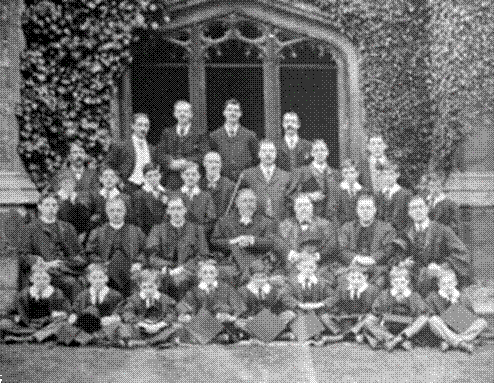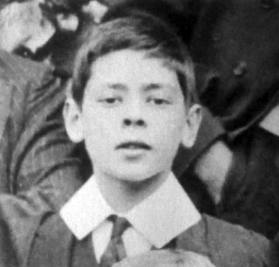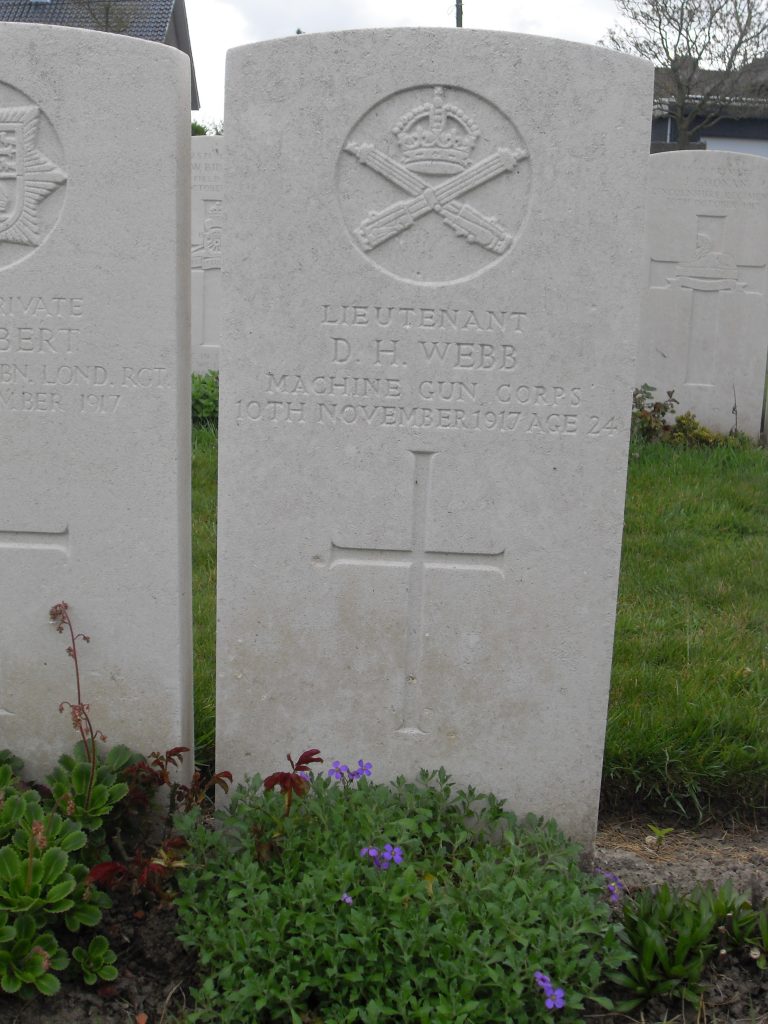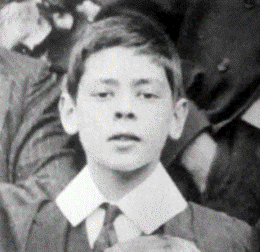Fact file:
Matriculated: N/A
Born: 14 September 1893
Died: 10 November 1917
Regiment: Machine Gun Corps
Grave/Memorial: Duhallow A[advanced] D[ressing] S[tation] Cemetery: III.B.20
Family background
b. 14 September 1893 at 18, Clifton Villas, Paddington/Maida Vale, London W2, as the only son (second child) of Thomas Henry Webb (1851–1913) and Alice Clarabel Webb (née Gomez) (b. 1864 in Calcutta, d. 1922 in South Devon]) (m. 1891). At the time of the 1901 Census, Webb’s mother was living at the above address (three servants). But according to the 1891, 1901 and 1911 Censuses, Thomas Henry and his two children were living with Thomas’s sister, Frances Lucinda Webb (1846–1927), at Lauriston Pines, [56,] Tor Hill Road, Torquay (two servants). By the time of Webb’s death, his mother was living at “Cedarcroft”, Torquay.
Parents and antecedents
Webb’s paternal grandfather, Thomas Webb (1818–86), was a cotton spinner and magistrate of Smallwood Manor, Marchington, Staffordshire, and Webb’s father was an organist who became a singing master and Professor of Music.
Webb’s mother was a professional singer of Spanish and Portuguese descent who went under the stage name of Madame Alice Gomez. She received her earliest instruction in music from her elder sister and continued her studies with Antonio Niccolini (conductor of the Calcutta (now Kolkata) Opera) before studying singing under her future husband when he was the organist at the Protestant Cathedral, Calcutta. After becoming well-known in Calcutta, first as a soprano and then as a contralto, she came to England in about 1885, where she made her first appearance on 14 July at a concert organized by her mentor and future husband. She was highly successful, and subsequently made occasional appearances at concerts and at homes until, in 1887, she sang at the Crystal Palace, after which she became famous as a leading concert performer, whose dark complexion and flowing saris generated a powerful stage presence. She appeared at major venues in London such as the Albert Hall and the Covent Garden promenade concerts, and also comparable venues in the provinces. She performed alongside such major singers as the diva Adelina Patti (1843–1919), the distinguished Anglo-American singer Antoinette Sterling (1850–1904), and the famous tenors Edward Lloyd (1845–1922) and John Sims Reeves (1818–1900). On 14 April 1894 she sang at a concert in the Queen’s Hall, Langham Place, London W1, alongside another contralto, Miss (later Dame) Clara Butt (1872–1936), who was by then a rising star.
She seems to have left her husband in the autumn of 1902 and moved to a flat at 24, Palace Gardens, Addison Bridge Place, London W14, where she lived until at least March 1908, paying a yearly rent of £110. The last-known report on one of her concerts to appear in the British press did so on 25 May 1907, and she had definitely returned to the Far East by 1912, for a report in the Singapore Times of 20 June leaves us with a good impression of her fame and prowess:
The long anticipated opportunity of hearing Madame Alice Gomez sing in Singapore occurred last night and the somewhat limited accommodation of the new Dutch Club in Cairnhill Road was completely taken up by an audience ready to appreciate the pleasures of the occasion. Madame Gomez was the bright particular star of the evening […] The noted cantatrice happily chose English as her metier of expression and opened with Sullivan’s rather dignified ‘Sleep, my beloved, sleep,’ in which the singer’s superb contralto notes rang rich and deep. It was followed by ‘Soul’s Blossom’ (Lehmann). In ‘Annie Laurie,’ which she sang to a vigorous recall, she expressed the sentiment beautifully but, on the whole, did not do herself full justice. It was different in the next series of selections. Opening with the little known gem of Mdlle Chaminade’s ‘The Silver Ring,’ she transported her audience immediately to realms of delight, and confirmed the pleasure with an aria in Italian which made opportunity to attain nearer to the full possibility of her mellow, flexible voice. Appreciation reached a climax on the irresistible appeal of ‘Farewell’ by Dyack; and the climax was capped by the rendering of Madame’s last and best effort, ‘Be good, sweet maid.’ On the whole, only one regret remains, and that is that Madame Gomez was not heard in an auditorium suited to the splendid capabilities of her strong voice. The limits of the club soon imposed a noticeable restraint.
By 1913, she had gone back to Calcutta, but returned to England to spend her final years in South Devon.
Siblings and their families
Webb’s sister was Dorothy Alice (b. c.1891, probably died abroad); later Jeans after her marriage in 1913 to Jacob William B. Jeans (b. 1882, probably died abroad); one son. During the war Dorothy lived in Oakford, Devon.
Jacob Jeans was a banker’s clerk who enlisted in the Army Service Corps on 7 November 1914 and disembarked in France on 24 September 1915, where he drove lorries and rose to the rank of Corporal. He survived the war, after which it seems likely that he and his family emigrated.

Magdalen College Choir (1907); Webb is the boy wearing glasses standing second from the left in the third row. The boy on his left is David Ivor Davies (1893–1951) who changed his surname to Ivor Novello in 1913. Ivor Novello became a song-writer and star of the stage, and later still a film actor and script-writer who made no secret of his homosexuality. His best-remembered creations are probably the song Keep the Home Fires Burning (1914), which became immensely popular during World War One, and the one-liner “Me Tarzan, you Jane.” (Photo courtesy of Magdalen College School)
Education and professional life
Webb attended Magdalen College School from January 1904 to 1912 and was a chorister from 1904 to 1908. Besides being a good singer, he also had academic and literary potential: he won the Form Vb Prize in 1908, a Modern Languages Prize in 1909, the Ellerton Exhibition (a prize awarded for the best performance by a Chorister in school examinations) in 1909, the Form Va Prize in 1910, and the Form VI and Va Repetition Prize in 1912. In 1911 he attained a Senior Certificate in the Joint Board Examinations, but in 1912 he was absent for his second set of Senior Certificate Examinations as he was in London taking alternative exams. In addition, “he had a happy turn with his pencil, and his school books were always decorated – in place of the official margin notes – with spirited little sketches and caricatures”. He became a House Prefect in 1910 and a Senior Prefect in 1911, besides which he served terms as the School’s Librarian (and thus ex officio Editor of The Lily) and Vice-President of the Debating Society. He was not a distinguished sportsman, but tried his hand with varying degrees of success at running, rowing, tennis, hockey and football.
He left school in July 1912 with the intention of going to university, but instead spent some time as a tutor in France, where he became proficient in French. On his return, he became an assistant schoolmaster in Yorkshire, and from there he went to assist another old boy and chorister, R.H. Alexander, who had a school of his own at Croydon. When he attested at Torquay on 14 September 1914, he gave his profession as Assistant School Master, his temporary address as 2, Middle Lane, Epsom, Surrey, and his permanent address as Lauriston Pines, Torquay.
Military service
Webb, who was 5 foot 9¾ inches tall, enlisted as a Private in the 20th (Service) Battalion (3rd Public Schools Battalion) on 14 September 1914 and spent the next few months training, probably at Leatherhead, Surrey. He applied for a Temporary Commission on 7 January 1915 and was commissioned Second Lieutenant in the 11th (Reserve) Battalion, the Devon Regiment, on 24 January 1915 (London Gazette, no. 29,051, 27 January 1915, p. 884), when his new Battalion was based in Torquay. On 10 April 1915 the Battalion changed status from a Service to a Reserve Battalion, and in May 1915 moved to Wareham, Dorset, as part of the 10th (Reserve) Brigade.
When the Machine Gun Corps (MGC) was established in October 1915 to provide the Army with specially trained men and more concentrated machine-gun fire (three Machine Gun companies per Division, rising to four in February/March 1918, each company equipped with 4 x 4 machine-guns), Webb transferred and was promoted Lieutenant in December 1915. He was then assigned to the MGC’s 2nd Company (established 26 January 1916), embarked at Southampton on 16 May 1916 and arrived in Le Havre on the following day. Unfortunately, we know very little about Webb’s activities since 2nd Company’s War Diary for 1916 is brief and sketchy and does not mention him. But after disembarking, Webb probably trained for three months at the MGC Base Depot at Camiers, about three miles north of Étaples on the French coast, and on 25 August 1916 he joined No. 2 MG Company of the 2nd Brigade while it was in Reserve at Maxse Redoubt, near Contalmaison, around five miles east of Albert on the Somme. The Company had been in line on the Somme as part of 1st Division since 18 July 1916 when the Division was involved in the attack on Guillemont and suffered very heavy casualties, with the War Diary of No. 2 Company alone recording that 22 of its members had been killed, wounded or missing. With hindsight, this is not surprising, since the MGC was known as “The Suicide Club” because of the dangerous nature of its work, and during World War One it suffered 36 per cent casualties (7.3 per cent killed in action).
The 2nd Company spent the second half of 1916 on the Somme and continued to support Brigade and Divisional attacks, mainly in the vicinity of Mametz Wood and Bazentin-le-Grand, with brief periods out of line at Baizieux and Millencourt, just to the south-west of Albert. But from 3 October to 5 November 1916, No. 2 Company was in Corps Reserve, which allowed Webb to spend from 26 October to 5 November 1916 on leave in Britain. He rejoined the 2nd Company in the field on 9 November 1916 and for the rest of November, when one of its guns was put out of action by enemy fire, it moved back into the trenches at Bazentin-le-Grand and Mametz Wood. In January 1917, Webb, who was an experienced editor, became responsible for writing up the War Diary and from 2 to 23 of that month the Company trained at Millencourt, about two miles west of Albert, before moving further south-west to Bresle, where it spent 24 January to 5 February in billets. But on 26 January 1917 Webb spent two days in hospital with scabies, a very common, itchy and contagious skin infection that was caused by poor living conditions and the parasite sarcoptes scabei, and was very common among front-line soldiers. In February 1917, No. 2 Company moved southwards to Méricourt-sur-Somme and then, after a brief spell in Péronne, went into line at Chuignolles, where they were primarily engaged for the month of March in firing at the German lines and at German aircraft. By the end of March the Company was in anti-aircraft positions at Brie, seven miles south of Péronne, guarding the Somme Bridge, and stayed there into April, when they moved back to Chuignes and Morcourt, where they trained in concealment, selection of gun positions, and firing for nearly the whole of May 1917. During this period, on 18 May 1917, Webb was given another ten days’ leave in England, but when, on 29 May, he tried to rejoin No. 2 Company at its old location, he discovered that during his absence it had moved northwards for 60 miles and had arrived by train in Méteren, just to the north-west of Bailleul in northern France, on 27 May.
The Company trained at various places in Belgium until 19 June and then went into the trenches for a week. On 24 June it went into camp for ten days and then, on 3 July, took up positions at the westernmost end of the Allied front line to the north of the Belgian coastal port of Nieuport-les-Bains (Nieuwpoort). Nieuwpoort is not far south of Oostende, where the River Yser (IJser) flows into the North Sea, and the area’s strategic importance was recognized as early as autumn 1914, when the Belgians halted the German advance by flooding the sea locks and opening the sluice gates at Nieuwpoort. The Belgians then remained in possession of an area that was about a mile in depth to the east of the Yser and to the north of the town until summer 1917, when they handed it over to the British, who were preparing a push up the coast in order to capture the main U-Boot base at Zeebrugge in conjunction with the opening of the Third Battle of Ypres (31 July–10 November 1917). But the Germans, who realized the value of Nieuwpoort as a base for their own coastal offensive, seem to have got wind of the plan and at 06.00 hours on 10 July 1917 they began shelling the area, while fighter-bombers destroyed the old and somewhat rickety bridges over the Yser. Then, just before 18.00 hours, the Germans, using flame-throwers, launched a shock attack along a 1,400-yard front and took the first three British lines with ease, capturing 1,300 prisoners of war as they did so and inflicting casualties amounting to 3,126 officers and other ranks killed, wounded or missing at very little cost to themselves. Operation Strandfest, as the assault was known in German – The Battle of the Dunes in English (see also T.S. Arnold and E. Walling) – virtually annihilated the 1st Battalion of the Northamptonshire Regiment and the 2nd Battalion of the King’s Royal Rifle Corps, both part of 2nd Brigade, in the 1st Division.
Webb’s Company was relieved on 15 July and marched from Nieuwpoort to Ghyvelde Camp, about 12 miles along the coast, and thence to the St-Pol-sur-Mer area of Dunkirk. But while in the front line, it had lost two officers and 55 other ranks killed, wounded or missing, and all 16 of its machine-guns, thus putting it out of action until 31 October, i.e. half-way through the closing phase of the Third Battle of Ypres, which became known as the Second Battle of Passchendaele. Webb was on leave in Paris from 10 to 15 September, when he rejoined his unit, and on leave in England from 24 October to 3 November. But on 22 October, No. 2 Company had moved 11 miles south to new billets in the village of Eringhem, and Webb rejoined it on 4 November 1917 just in time for its move to Poperinghe on 6 November 1917. At 01.10 hours on 9 November, i.e. the penultimate day of Third Ypres, the Company moved to their four new battery positions, with Webb in charge of one of them. Webb was killed during the action of 10 November 1917, aged 24, probably near Passchendaele village during the attack by British troops and the 1st Canadian Division. He is buried in Duhallow ADS Cemetery (north of Ypres), Grave III.B.20 (20 paces away from A.A. Steward, another chorister and alumnus of Magdalen College School); he is also commemorated on Torquay War Memorial. He left £142 7s. 2d.
Bibliography
For the books and archives referred to here in short form, refer to the Slow Dusk Bibliography and Archival Sources.
Printed sources:
[Anon.], ‘Killed in Action: Henry Webb, M.G.C. (formerly Devon Regiment)’, The Lily, 11, no. 15 (December 1917), pp. 185–6.
McCarthy (1998), pp. 50–1.
Steel and Hart (2001), pp. 295–300.
Bebbington (2014), pp. 303–08.
Archival sources:
MCA: PR/2/18 (President Warren’s Notebooks), p. 290.
WO95/1273.
WO339/32721.



